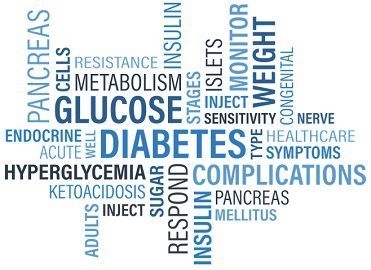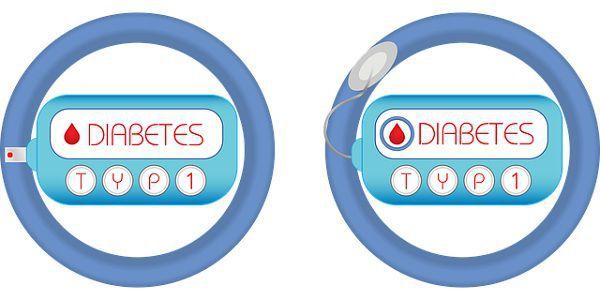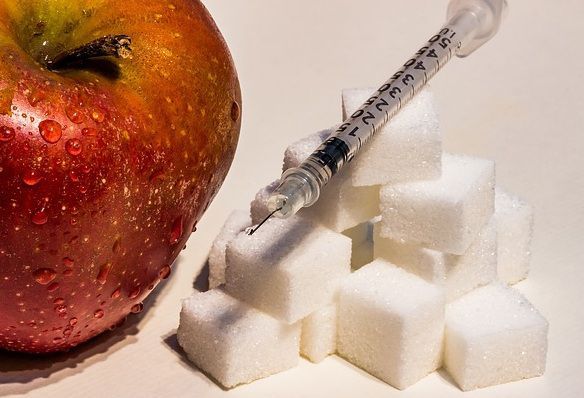Type 1 diabetes is considered as the autoimmune disease, while Type 2 is said as progressive disease. Also, Type 2 is much more common than the type 1. Both the types are characterized by the higher blood sugar level as compared to the normal one. But the basic difference between type 1 and type 2 diabetes is their cause and development.
Diabetes is nowadays very common metabolic disorder, where the body is unable to store and use the sugar (glucose) which is found in blood and work as fuel for the body’s function. Diabetes is categorized as Type 1, Type 2 and gestational diabetes.
Type 1 and 2 are the common disorders but Gestational diabetes occurs to the female at the time of pregnancy and resolves after the childbirth. Earlier Type 1 diabetes was known as juvenile onset or insulin-dependent diabetes and Type 2 diabetes was known as adult onset or non-insulin-dependent diabetes.
Such medical condition (diabetes) arises due to the hormone called Insulin produced by the beta cells in the pancreas. This insulin is responsible for regulating blood sugar which in turn provides energy to the body’s cells and tissues. This is done by moving the sugar to all tissues and cells through blood with the help of insulin. But due to dysfunctioning in the insulin hormone, the flow of sugar (glucose) gets improper and thus results in diabetes.
Diabetes has the higher risk of cardiovascular diseases, vision loss, disease related to kidney, neurological conditions and another organ may also get damage. In the following article, we will take up the most important points which distinguish the Type 1 diabetes with that of Type 2 and brief descriptions of them.
Content: Type 1 Vs Type 2 Diabetes
Comparison Chart
| Basis for Comparison | Type 1 diabetes | Type 2 diabetes |
|---|---|---|
| Meaning | Type 1 diabetes is an autoimmune disease, in which body's immune system attacks and destroys the beta cells of the pancreas, which are responsible for making insulin. | In the case of Type 2 diabetes, the body is not able to make or use the insulin up to the mark or requirement. |
| Cause | The main cause of getting Type 1 diabetes is that the body's immune system itself starts destroying the cells (beta cells) that release the insulin and thus the insulin production stops in the body. This result in less energy in the body as the cell is unable to absorb energy from the blood. | In the case Type 2 diabetes the body is not able to use the insulin in the right way, this is known as insulin resistance and later on the condition gets worse when pancreas starts making very less insulin, giving rise to insulin deficiency |
| Age of Onset | Type 1 diabetes is usually diagnosed in children and young adults. | It is usually diagnosed in adulthood, older people, but it is diagnosed in children also these days. |
| Signs and Symptoms | 1.Frequent urination. 2.Weight loss. 3.Extreme thirst and hunger. 4.Vomiting and nausea. 5.Extreme weakness and fatigue. 6.Irritability. | 1. Frequent urination. 2. Irritability. 3.Blurred vision. 4. Skin infections. 5. Weight loss. 6. Thirst and hunger. 7. Frequent urination. 8. Dry and itchy skin. 9. Numbness in the skin. |
| Test and Diagnosis | 1.Fasting plasma glucose (FPG) test - It is best to take the test in the morning, after fasting for at least 8 hours. 2.A1C test - A1C test is the normal test and can be taken anytime, it provides the average result of the blood glucose level over the past 3 months. 3.Random plasma glucose (RPG) test - When the doctor notice the signs of diabetes, there is an instant test without any fasting this is called RPG or Random plasma glucose test. | 1.Fasting plasma glucose (FPG) test - It is best to take the test in the morning, after fasting for at least 8 hours. 2.A1C test - A1C test is the normal test and can be taken anytime, it provides the average result of the blood glucose level over the past 3 months. 3.Random plasma glucose (RPG) test - When the doctor notice the signs of diabetes, there is an instant test without any fasting this is called RPG or Random plasma glucose test. |
| Risk factors | Frequent episodes of low-blood sugar (hypoglycemia). | Fewer chances of having low-blood sugar, unless the patient is using the diabetes medicine or insulin. |
| Ketoacidosis or diabetic coma, high blood pressure, low blood sugar (hypoglycemia), ulcers, kidney disease, blindness, heart attack, high blood pressure, ulcers. | Ketoacidosis or diabetic coma, high blood pressure, low blood sugar, blindness, heart attack, kidney disease, nephropathy, neuropathy, ulcers, stroke. |
|
| Apart from the genetic factors, there are certain genes responsible for this condition. | In this type, family history plays the significant role. | |
| Type 1 may also occur due to rubella, mumps, or viral infections. | The main cause is the change in the life style, obesity, unhealthy diet, also the genetic factors. |
|
| Treatment | A healthy diet, oral medications, physical activity, regulating blood pressure, injections of insulin is important. | Taking diabetic medicines, injections of insulin, regular exercise, controlling blood pressure, maintaining the cholesterol level, taking healthy diet. |
| Prevention | It cannot be prevented as it is autoimmune that attack on beta cells, producing insulin. | It can be delayed or prevented by maintaining the proper balance diet, sensible eating and exercising regularly. |
Definition of Type 1 Diabetes
In Type 1 diabetes, the body is unable to produce the sufficient amount of insulin, due to an overactive immune system. This result in the lack of energy production in the body. The main role is played by the beta cells, which are present in the pancreas. As these (beta cells) are the only one which produces insulin, but in this case, the body’s immune system itself destroys the beta cells, and thus the production of insulin gets disturbed.
Insulin is the hormone that helps in moving sugar or glucose to the body’s tissue through blood. Cells take this glucose as a fuel and perform various activities. But due to this autoimmune destruction of the beta cells, the whole process gets off, and glucose is not able to move to the cells and other parts of the body. Instead, it accumulates in the blood and the cells starve. This causes high blood sugar, which leads to weight loss, diabetic ketoacidosis, dehydration, frequent urination, damage to the body.
Type 1 diabetes is usually seen in childhood or sometimes in the adult. Overall 5 percent people have this type, affecting men and women equally.
Nausea and vomiting, dry mouth, belly pain, frequent urination, fatigue, blurred vision, weight loss, increased hunger, blurred vision, infections of the skin, urinary tract are the symptoms of type 1 diabetes. Meanwhile, the signs like rapid breathing, belly pain, confusion, and shaking are also checked.
However it can’t be prevented entirely, but it can be treated by keeping the blood sugar level in control by maintaining the proper and healthy diet, taking regular insulin injections and other medication advised by the doctor. If it is not treated well, type 1 may result in kidney damage, poor blood circulation, retinopathy.
Definition of Type 2 Diabetes
In Type 2 diabetes the body prevents the insulin to function correctly, and there is the lack of insulin according to the requirement. Today 90-95 percent people suffer from the type 2 diabetes overall. Diabetes is a life-long disease that may happen at any stage of life. Usually, type 2 is noticed in older age, though it may get diagnosed in younger adults also.
In this case, the beta cells of the pancreas make the hormone called insulin. But the cells of the body is not able to use them well as per the requirement. This is called insulin resistance. First, the pancreas produces more insulin so to fulfill the demand of the glucose into the cells. But it can’t keep up, and the sugar assembles in the blood instead.
Type 2 diabetes can be hereditary, due to the imbalance in genes, over or extra weight, metabolic syndrome, too much glucose from the liver, or due to destroyed beta cells. Blurry vision, tingling or numbness in the hands or feet, wounds that do not heal, frequent urination are the symptoms of type 2 diabetes.
Other risk factors include stress, no physical activity or exercise, smoking, sleeping too much or too little, unhealthy life style.
Diagnosis of both the types 1 and 2 is done by A1C test, Fasting plasma glucose, Oral glucose tolerance test (OGTT). As it is a life -long disease it may damage the kidneys, eyes, heart and blood vessels, wounds healing, during pregnancy as well nerves.
So the best way to avoid such complications is to manage diabetes at some point, to do this one should regularly check the blood glucose level, taking the medications and insulin on time, proper and healthy meal without skip should be followed and visit the doctor regularly.
Key Differences Between Type 1 and Type 2 Diabetes
Given below are the substantial points, which mark the difference between the Type 1 and Type 2 diabetes:
- When the body’s immune system attacks and destroys the beta cells, responsible for making insulin it results in the Type 1 diabetes. This result in the low absorption of the glucose from the blood and hence low energy in the body so Type 1 diabetes is called as the autoimmune disease. But in the case of Type 2 diabetes, the body is unable to make or use the insulin up to the mark or requirement.
- As discussed above the primary cause of getting Type 1 diabetes is the body’s immune system itself which starts destroying the cells (beta cells) that release the insulin and thus the insulin production stops in the body. This result in less energy in the body. Type 1 diabetes is usually noticed in childhood and the young adults. On the other hand in Type 2 diabetes the body is not able to use the insulin in the right way, this is known as insulin resistance, and later on, the condition gets worse when pancreas starts making very less insulin, giving rise to insulin deficiency. It is usually diagnosed in adulthood, older people, but during these days it is noticed in children also.
- Signs and Symptoms are almost common in both the types like frequent urination, weight loss, extreme thirst and hunger, vomiting and nausea, extreme weakness and fatigue, irritability, blurred vision, dry and itchy skin, numbness in skin, thirst, and hunger.
- Test of the types are common which include: Fasting plasma glucose (FPG) test – It is best to take the test in the morning, after fasting for at least 8 hours.
A1C test – The A1C test is the normal test and can be taken anytime, it provides the average result of the blood glucose level over the past 3 months.
Random plasma glucose (RPG) test – When the doctor notices the signs of diabetes, this is an instant test without any fasting this is called RPG or Random plasma glucose test. Although these tests are not applicable for gestational diabetes. - Risk factors of type 1 are frequent episodes of low-blood sugar (hypoglycemia), Ketoacidosis or diabetic coma, high blood pressure, low blood sugar (hypoglycemia), ulcers, kidney disease, blindness, heart attack, high blood pressure, ulcers. On the contrary Type 2 diabetes have fewer chances of having low-blood sugar unless the patient is using the diabetes medicine or insulin. Although risk factors include ketoacidosis or diabetic coma, high blood pressure, low blood sugar, blindness, heart attack, kidney disease, nephropathy, neuropathy, ulcers, stroke.
- Apart from the above, genetic factors as well certain genes are also responsible for this condition. Type 1 may also occur due to rubella, mumps, or viral infections. Though in Type 2 family history plays the significant role and other main cause is the change in the life style, obesity, unhealthy diet, also the genetic factor.
- A healthy diet, physical activity, oral medications, regulating blood pressure, maintaining the diet, injections of insulin is important are the way to treat Type 1 diabetes. Whereas there is no prevention of this type as it is autoimmune that attack on beta cells, producing insulin. On the other hand Type 2 diabetes treatment include – taking diabetic medicines, injections of insulin, regular exercise, controlling blood pressure, maintaining the cholesterol level, taking healthy diet. Type 2 diabetes can be controlled or prevented by maintaining the proper balance diet, sensible eating and exercising regularly.
Conclusion
We can say that while both the Types 1 and 2 are characterized by checking the higher blood sugar level than the normal, though the cause and development are different of both. There are many perceptions regarding diabetes like overweight, feeling lethargic, weakness, but these are not always true.
As these types may vary and are unpredictable sometimes, even it ‘s hard to detect the type of diabetes, from which the person is suffering from. So one should consult the health care professional if notice the symptoms of diabetes or other medical related issues.




Comfortfinds says
Well Described! Keep up the good writing.